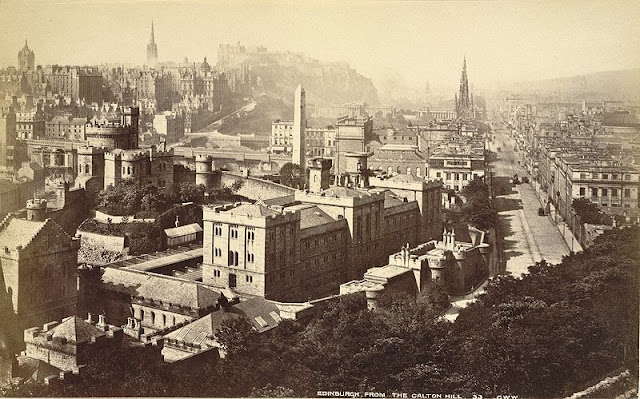This grand building was once the governors house belonging to Edinburgh's notorious Calton Jail. Built in 1817 on windy Calton Hill. This replaced the old Tollbooth, called the 'Heart of Midlothian,' a building that had been used in several guises, including Guildhall as well as prison, over the years. Walter Scott's famous book 'The Heart of Midlothian,' describes something of that building and its place in Edinburgh society. The governors house of Calton Jail was designed by Archibald Elliot and may well have been warmer than the rest of the building, designed by Robert Adam, which became renown for being very cold, having a poor diet, and the strict discipline demanded from the inmates.
The name Calton some reckon comes from 'Cold Town,' which is understandable in Edinburgh, but it is precedes such a phrase and most likely arises from the Gaelic "cauldh-dun," which means 'Black Hill,' as the hill comprises black basalt. Edinburgh's position allows the citizens, once crushed together in the crowded old town, to escape to the hills right on their doorstep. King James the second allowed tournaments there in the 1400's and theatrical productions soon followed. Later use of the hill included a hospital, a monastery and a small village of shoemakers, called 'Boot Hill' perhaps? The small area of land they inhabited later becoming the famous Old Calton Cemetery. David Hume being one of the more renown people buried therein. Edinburgh as you will know being famous for being the 'Athens of the North,' still produces many leading men of the day. Interestingly, I, and our good friend Mike Smith, hail from that city. Next to the Calton jail stood the debtors prison, the Brideswell, also designed by Robert Adam. Debt today leads to much hardship, in times past it led to prison and in some cases hanging! How banks would hate that today!
Talking of hanging, Jessie King was the last woman to be hanged there in 1889. She spent her time looking after unwanted children, and murdering a few of them. Another hanged, in 1913, was Patrick Higgins. He murdered his two sons and dumped them into a quarry. Both lie, alongside several others, underneath the West car park of St Andrews House.
Egalitarian Edinburgh, with the famous Georgian 'New Town' buildings, possessed a powerful 'high society,' sophisticated legal structures, Calvinist ministers, and enterprising commercial businessmen yet contained many slum dwellings. This increased with Irish immigration during the 1800's which brought some 25,000 to dwell in the run down centres such as the Cowgate, mixing with those already overcrowded there. Criminal elements were found even in Scotland's capital and criminals of all types mixed with desperate people, drunks, lunatics, brought there by their desperation, poverty or sheer criminal nature. Poor diet and bad health caused many diseases for those who survived beyond the early years often leading to criminal or abnormal behaviour. The well-to-do who had suffered this way still managed to prove the depth to which human nature is possible by finding a place within Calton Jails walls. Wealth often increasing greed rather than ending it.
During the Great War several leading socialists in Glasgow loudly opposed the war, as they did the increases in rent women left behind were asked to pay. This led to them being jailed, and to make it worse they were sent to an Edinburgh jail at that! It was felt they would spread dissension more in a Glasgow prison. Willie Gallacher was one such detained there. He was one who complained of the cold, the total silence, only whispered conversations during the one hours exercise available, and the poor diet. Thick porridge and sour milk was the breakfast, soup and dry bread comprised dinner and supper was similar to breakfast. Arthur Woodburn was also jailed with Gallcher, he later became Labour's Secretary of State for Scotland in 1947, by which time the jail had been demolished. He used some of the stones to make a garden path for his home! What satisfaction that must have brought!
The jail was replaced in the 1930's by Saughton prison and St Andrews House now stands in its place. Home to Scotland's most senior civil servants. One day soon this will be part of the Independent Scotland's government machine. I suspect, whatever the situation, that the diet available there today does not involve porridge and sour milk!
Incidentally the tall needle next to the house, which is now used as offices, is the Martyrs Monument. This is a Political Monument commemorating those who campaigned for political freedoms in the 18th and 19th centuries. Five men who were transported to Australia for fifteen years for their desire for equality! The dominant force, whether just or unjust, always gets its way. At least the sun shone there!
.




